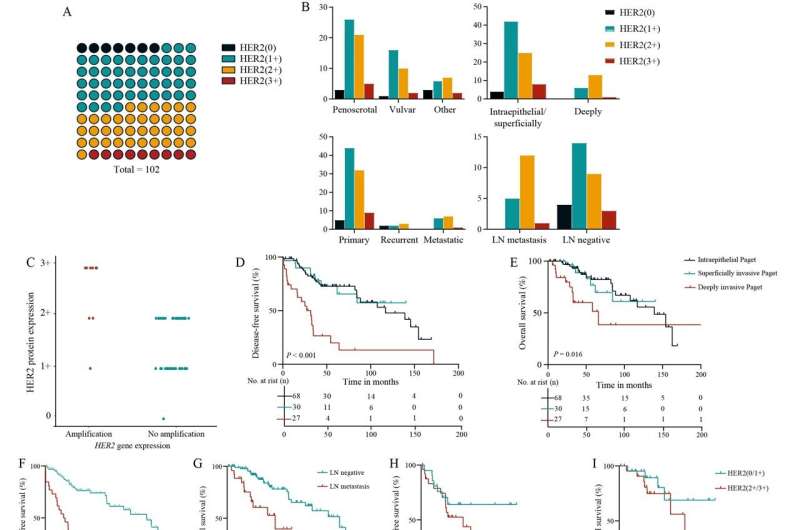This article has been reviewed according to Science X's editorial process and policies. Editors have highlighted the following attributes while ensuring the content's credibility:
fact-checked
proofread
Assessment of HER2 status in extramammary Paget disease and its implication for disitamab vedotin

Research published in Frontiers of Medicine evaluates the human epidermal growth factor receptor 2 (HER2) status in extramammary Paget disease (EMPD) and explores the therapeutic potential of disitamab vedotin (DV), a novel humanized anti-HER2 antibody-drug conjugate (ADC), for this rare adenocarcinoma.
EMPD typically arises in the apocrine gland-rich skin and can be categorized as primary or secondary, with the latter indicating the intraepithelial spread of an underlying visceral carcinoma. Surgery is a common treatment for intraepithelial EMPD, while chemotherapy and targeted therapy are considered for advanced cases.
HER2 overexpression or amplification is a known poor prognostic indicator in various malignancies and has been previously studied in EMPD, albeit with limited sample sizes. The rates of HER2 overexpression in EMPD have varied significantly across studies. The research addresses this gap by conducting a retrospective study involving 129 EMPD cases from three medical centers, aiming to assess HER2 status through immunohistochemical (IHC) staining and fluorescence in-situ hybridization (FISH) analysis.
The study found that HER2 protein expression was detected in a significant proportion of cases, with varying scores indicating different levels of expression. Notably, the presence of HER2 2+ and 3+ scores was slightly more frequent in invasive EMPD compared to intraepithelial EMPD. Additionally, a higher frequency of lymph node metastasis was associated with HER2 2+/3+ scores, suggesting a correlation between HER2 expression levels and the aggressiveness of the disease.
The study also reports on the use of DV in two patients with advanced EMPD who had previously failed to respond to chemotherapy. Both patients exhibited partial responses to DV treatment, as assessed using the modified RECIST 1.1 criteria. This finding suggests that even patients with low HER2 expression levels may benefit from HER2-targeted therapy, expanding the potential patient population for such treatments.
The research underscores the importance of HER2 as a potential therapeutic target in EMPD and highlights the need for further investigation into HER2-targeted ADC therapies like DV. The study's findings indicate that a significant proportion of EMPD cases exhibit HER2 expression, supporting the potential use of HER2-targeted therapies in these patients.
The study's strengths include its multicenter design and focus on low HER2 expression levels in EMPD, which has not been extensively explored in previous research.
In conclusion, the study presents valuable insights into the role of HER2 in EMPD and the potential application of HER2-targeted ADC therapy, particularly DV, in the treatment of this rare malignancy.
The findings suggest that HER2 expression, even at low levels, may be targetable by DV, offering a new perspective on the treatment of EMPD. Further research and clinical trials are warranted to evaluate the efficacy and safety of ADC therapy in a larger cohort of EMPD patients.
More information: Jia Jia et al, Assessment of HER2 status in extramammary Paget disease and its implication for disitamab vedotin, a novel humanized anti-HER2 antibody-drug conjugate therapy, Frontiers of Medicine (2024). DOI: 10.1007/s11684-023-1046-2
















